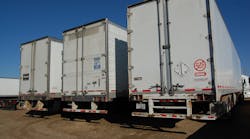The transportation sector as a whole in the U.S. is projected to witness significant growth this year, with all modes – including trucking, railroads and even the airline industry – expected to retain “sufficient pricing power and volumes,” according several reports.
“All transportation sectors are expected to see a continued, moderately accelerating pace of growth through 2015, building on the improved 2014 growth rates,” noted Tanya Langman, a director with Fitch Ratings, in a statement.
However, she added that “some tapering” in transportation activity will occur due to winter “weather-related losses,” particularly in the Northeast and Midwest.
As part of Fitch’s transportation analysis for 2015, where air travel is concerned, the firm expects airport passenger traffic growth of about 2.5% to 3% this year, based on general economic improvement, lower fuel prices and rising seating capacity at most U.S.-based carriers.
Getting cargo through the West Coast ports, however, remains something of a sticking point, Langman noted, with freight throughput results “to show meaningful declines” in first-quarter due to the just-resolved labor slowdown.
As a result, East Coast ports may see increased volumes for cargo diverted from the West Coast – a trend Fitch said it will “monitor closely” over the next several months.
Where trucking is concerned, David Ross, managing director with Wall Street investment firm Stifel Nicolaus & Co., thinks that while 2015 may not be quite as robust as 2014, rates should continue to go up as truck-borne freight volumes keep increasing while capacity remains tight.
Stifel is currently predicting that contract TL rate increases should jump 3% to 5% in the first half of 2015 on a year-over-year basis, with dedicated TL rates climbing 2% to 4%.
Where LTL is concerned, yields are expected to grow 3% to 4% this year, as some capacity tightness drives higher pricing.
“Actual results could be higher/lower depending on TL/LTL industry capacity, freight growth, and carrier capacity/pricing discipline,” Ross noted. “Structurally, pricing momentum remains with the LTL carriers. We believe that long-term pricing should continue to rise, given the industry’s high degree of consolidation, with the top-five LTL carriers controlling 55% of the market.”
He added that U.S. freight transportation landscape over the next couple of years will be capacity-constrained due to rising volumes and flattish capacity, given driver shortage issues and added government regulations.
“Our models assume low-to-mid-single-digit rate increases; however, when/if it becomes real tight, rates should move up much higher – into the double-digits – in our view,” Ross said.
One reason behind the growing confidence in trucking’s ability to win further rate increases in trucking is that the U.S. manufacturing sector is expected to remain strong this – generating more freight for motor carriers to haul.
Although the potential impact of the strong dollar is causing uncertainty, optimism among U.S. industrial manufacturers regarding the direction of the domestic economy continues to rise, according to Pricewaterhouse Cooper’s (PwC’s) Q1 2015 Manufacturing Barometer.
However, that “broad sense of optimism” about overall economic conditions and improvements in global demand is being offset to a degree by concerns about pricing and margins, plus the potential impact of currency on international revenues, noted Bobby Bono, PwC's U.S. industrial manufacturing leader.
"As we see increasingly positive views about the domestic economy among U.S. industrial manufacturers, a majority of management teams continue to indicate plans to hire skilled workers and invest in their businesses, with the bulk of spending centered on new products or service introductions," he added.
"We also saw a spike in sentiment regarding potential M&A activity, while plans to expand abroad softened, reflecting increased concerns about the impact of the strengthening dollar,” Bono noted. “Overall, the outlook for U.S. industrial manufacturers remains positive and we are seeing healthy levels of capital investment."
According to PwC’s poll, optimism regarding the prospects of the U.S. economy during the next 12 months increased among U.S. industrial manufacturers to 76% during the first quarter of 2015, up from 68% in the fourth quarter of last year – the highest “optimism level” recorded by PwC since the fourth quarter of 2005.
Despite the positive sentiment, manufacturers are trimming their growth forecasts slightly, primarily due to reduced expectations regarding the level of sales contributions from international operations.
PwC’s survey also found that plans for operational spending jumped to 83% of respondents in the first quarter this year – the highest level in 10 quarters – with the targets for new spending including: new product or service introductions (55%), research and development (40%) and information technology (33%).
"The impact of the rising dollar on exchange rates has fueled increased concerns regarding the level of international sales, causing some management teams to pull back modestly on overseas investments until the outlook becomes clearer," Bono noted.
"At the same time, the growing U.S. economy and ongoing competitive environment is influencing the flow of capital into research and development, information technology and transactional activity on the domestic front,” he said. “We'll be closely watching this dichotomy of spending and its potential impacts on the U.S. manufacturing environment in the year ahead."



